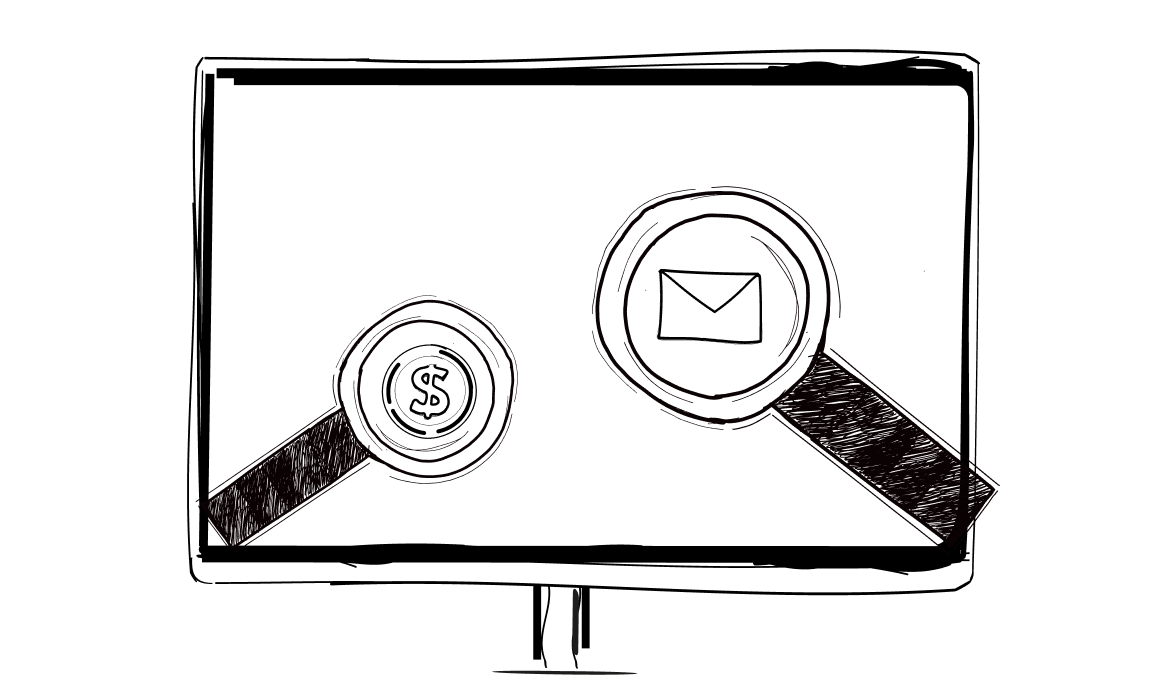Running a digital marketing agency can be very challenging. One quarter your pipeline is full, the next you’re chasing invoices and worrying about payroll. That feast-or-famine cycle is the single biggest threat to growth.
The fix? A predictable lead generation strategy.
Not another blog on “why SEO matters,” but a playbook for generating high quality leads in a crowded market where AI tools and shrinking budgets make it harder than ever to win attention.
This guide is written for agency founders, growth leads, and sales teams who need to keep their calendars full.
We’ll go beyond generic tactics and show how agencies can use their own marketing as proof, position themselves as thought leaders, and build systems that deliver sustainable growth. From scrappy startups to established players, you’ll learn how to attract the right potential clients and keep your sales pipeline moving.
Why lead generation agencies must generate leads predictably
Digital marketing services are increasingly commoditized. Eighty-four percent of agencies now position themselves as specialists, since the generalist model no longer differentiates in a market where clients can spin up a Google Business Profile, run self-serve advertising campaigns, or in-house digital strategy with AI tools.
The real threat isn’t just automation but the erosion of pricing power and loyalty for agencies that fail to offer clear, differentiated value.
When agencies lack a structured system to generate leads, the impact is severe:
- empty project calendars,
- sales teams chasing low-value opportunities,
- and inconsistent cash flow that makes planning nearly impossible.
Referrals may be high-trust, but they offer minimal pipeline control and little forecasting power.
The upside is clear. Ninety-one percent of marketers now rank lead generation as their top goal, and those with structured systems see the payoff.
Companies that excel at structured lead nurturing generate more sales-ready leads at lower costs than firms with unstructured approaches.
Multi-channel campaigns that integrate email, LinkedIn, and calls deliver 40% higher response rates and 31% lower cost per lead than single-channel efforts.
The lesson?
Treat lead generation efforts as a core business function, not an afterthought. Agencies that build a repeatable lead generation process consistently win better contracts, improve conversion rates, and position themselves for sustainable growth.
Challenges in the agency lead generation process
Agencies face unique hurdles when trying to generate leads, and recent Forbes coverage underscores just how serious these barriers have become.
Trust gap
B2B buyers increasingly demand “personalized, timely, and cross-channel engagement,” according to the Forbes Agency Council. Clients are quick to tune out generic pitches from “marketers marketing marketing” and only trust agencies that can demonstrate expertise and deliver value upfront.
Commoditization and competition
Forbes has called commoditization the single biggest threat to agencies in 2025, bigger than AI itself. Thousands of lead generation agencies now compete in a crowded market, and those relying on price competition or vague “ROI-driven digital marketing strategies” face what Forbes describes as a “race to the bottom.” Buyers want differentiation and proof, not empty promises.
Lengthy sales cycles
According to Forbes Advisor, average sales cycle times have grown by more than 50% in recent years, with many high-value deals (over $250,000) taking six months or more to close. For agencies targeting mid-market or enterprise decision makers, this delay stretches resources thin and makes pipeline predictability harder to achieve.
Lead quality issues
Forbes reporting shows that poor qualification is one of the top reasons why up to 79% of leads never convert. Even worse, only 20% of sales-qualified leads receive proper follow-up, highlighting the danger of confusing activity and volume with meaningful outcomes.
This means agencies can’t afford to rely on random blogs, untargeted ads, or half-hearted outreach. They need a lead generation approach built on proof and structured systems that prioritize quality over volume.
How to generate leads with creative plays that stand out
Generic content and cold outreach won’t cut it. Agencies that will win high quality leads in 2025/26 and 2026 are doing things differently.
Drink your own champagne
Run your own advertising campaigns on social or search engines. Show prospects the ROI you delivered for yourself. If you’re a PPC agency, run a small Google Ads campaign targeting high intent keywords, capture contact details, and use the results as a mini case study.
Mini audits as magnets
Instead of bland lead magnets, send personalized messages with quick teardowns of a prospect’s SEO or social media marketing. A 10-minute audit video often converts better than a whitepaper. It demonstrates expertise while opening the door to ongoing communication.
Thought-leadership funnels
Clients want valuable insights, not recycled advice. Host webinars (see examples below), publish industry benchmarks, or share your own data reports. For example, a SaaS-focused agency could release a “2025 SaaS Ads Benchmark Report” and capture new leads through gated downloads.
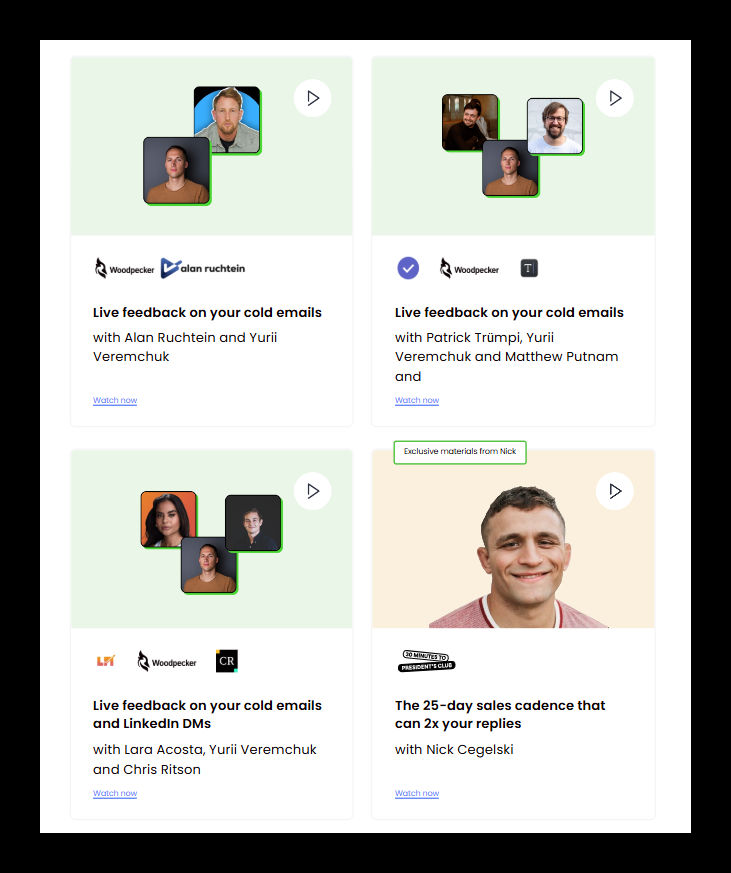
Showcase past wins
Turn your best projects into interactive case studies. Short videos where your client explains how you grew their revenue are powerful lead magnets. These stories help nurture potential customers deeper into the sales funnel.
Category design
Stop selling generic “digital marketing strategies.” Package your process as a unique framework, like “The 4-Week Growth Sprint.” Naming your methodology positions you as the inventor. This, in turn, makes you harder to compare on price.
Mini case-study examples
Scrappy startup example
Take a 2-person agency in Lisbon. With no budget for ads and little brand recognition, they had to be scrappy. Their solution? Free 15-minute LinkedIn audits for ecommerce founders.
Instead of pushing a generic sales pitch, they recorded short Loom videos pointing out specific gaps in each founder’s profile and content strategy: things like inconsistent branding, missing Google Business Profile links, or poor use of high intent keywords in posts.
The audits weren’t fancy, but they were personal and actionable. Within two months, the agency had sent 40 audits, booked 10 discovery calls, and converted 3 of those founders into paying clients. For a small shop, that meant sustainable revenue growth and the beginnings of a repeatable lead generation process.
This shows how startups can generate high quality leads without spending on paid advertising. All by investing time, creativity, and direct value instead.

Established agency example
Now contrast that with a 40-person B2B agency in Chicago. Competing for enterprise accounts meant they needed authority, not just hustle. They decided to publish an annual benchmark report on SaaS ad performance.
The marketing team gathered data from dozens of campaigns. They analyzed conversion rates across social media platforms and search engines, and then packaged the findings into a polished 40-page report. The report included charts, best practices, and actionable insights for CMOs managing multi-channel budgets.
To promote it, they combined content marketing with outbound lead generation.
The sales team used Woodpecker to send personalized messages to targeted CMOs, pointing them to the report. Meanwhile, the agency ran LinkedIn advertising campaigns aimed at SaaS founders using high intent keywords like “B2B ad benchmarks” and “improve SaaS conversion rates.”
The results? 1,200 downloads in six weeks, 45 booked calls with CMOs in their target audience, and 6 enterprise contracts entering the sales pipeline.
For a larger agency, the benchmark positioned them as an industry thought leader and fueled sustainable growth through repeatable lead generation efforts.
Expanded budget-based guidance
Lead generation looks different depending on your agency’s stage and resources. The right play for a scrappy startup isn’t the same as what a 50-person agency should run.
Here’s how to approach it by budget and scale:
For small agencies:
If you’re a two- to five-person shop, cash is tight.
- Skip expensive advertising campaigns and double down on time-based tactics.
- Run free mini audits, post actionable social media marketing content, and use Woodpecker to send personalized messages to a narrow, well-defined target audience.
- Add early social proof by collecting testimonials from your first few projects and showcasing them as social media posts or quick case studies.
These moves are low-cost but high-effort – the exact trade-off that helps you generate high quality leads without burning your budget.
For mid-size agencies:
Once you hit 10-25 people, your marketing team can split its energy across more marketing channels.
- Now is the time to run webinars, publish templates and calculators, and start partnerships with complementary SaaS tools. Co-marketing campaigns not only attract leads but also expand your reach into other marketing channels without doubling ad spend.
- At this stage, invest in aligning your sales team focuses with inbound campaigns, so every potential customer gets nurtured from first touch through the sales funnel.
For larger agencies:
If you’re running a 40-100 person shop, you need authority plays to reach enterprise decision makers.
- Invest in publishing original benchmark studies, launching your own category design (like “The 6-Week B2B Demand Sprint”), and creating branded playbooks that showcase deep industry expertise.
- Pair these with account based marketing campaigns targeting a curated list of most promising prospects.
At this scale, your lead generation efforts should fuel consistent revenue growth by positioning you as the go-to partner, not just another vendor.
Winning qualified leads with outbound lead generation
Outbound has a bad reputation because most agencies do it badly. Bulk spam emails, generic LinkedIn pitches, and irrelevant cold calls that damage your brand.
Done right, outbound is one of the fastest routes to generating high quality leads. The key is personalization at scale.
And the data backs it up. Having analyzed over 20 million cold emails, we noticed that campaigns that use advanced personalization see a 17% reply rate, compared to just 7% for generic emails. That’s more than double the response simply by tailoring your message beyond a {{first_name}} tag.
List quality matters too.
A smaller, carefully chosen list of most promising prospects consistently performs better than a broad blast. In one Woodpecker dataset, narrowing outreach from 1,000 generic contacts to 100 highly-targeted ones increased replies from 2% to 40%.
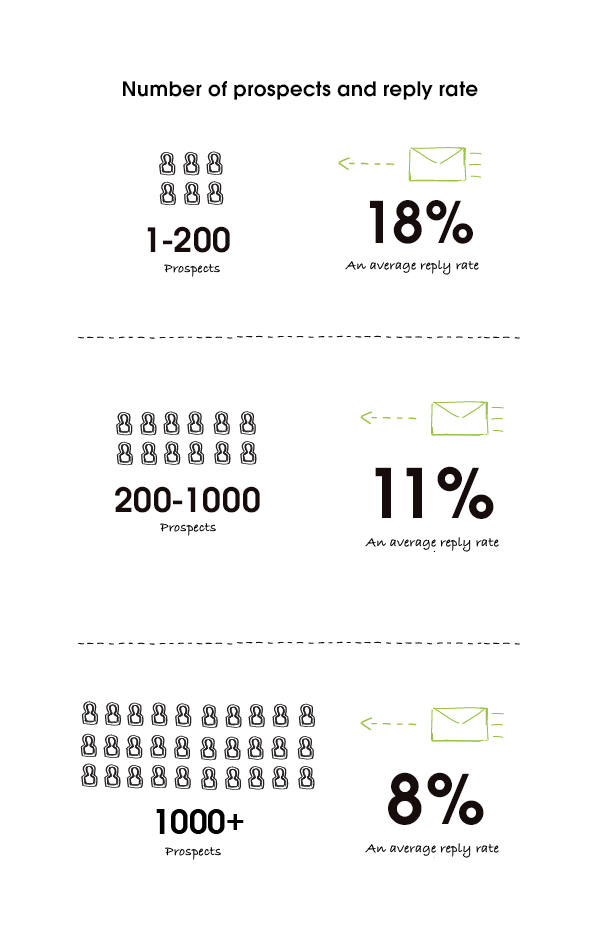
Follow-ups are another critical piece. Campaigns with 4-7 touchpoints had reply rates three times higher than those with only 1-3. This proves that outbound lead generation is about structured persistence and ongoing communication.
Agencies can put this into practice by using Woodpecker to:
- build segmented campaigns targeting decision makers,
- insert 2-3 custom snippets for each prospect,
- automate 4-6 follow-ups with varied timing to improve response,
- track deliverability, open rates, and conversion rates to refine campaigns.
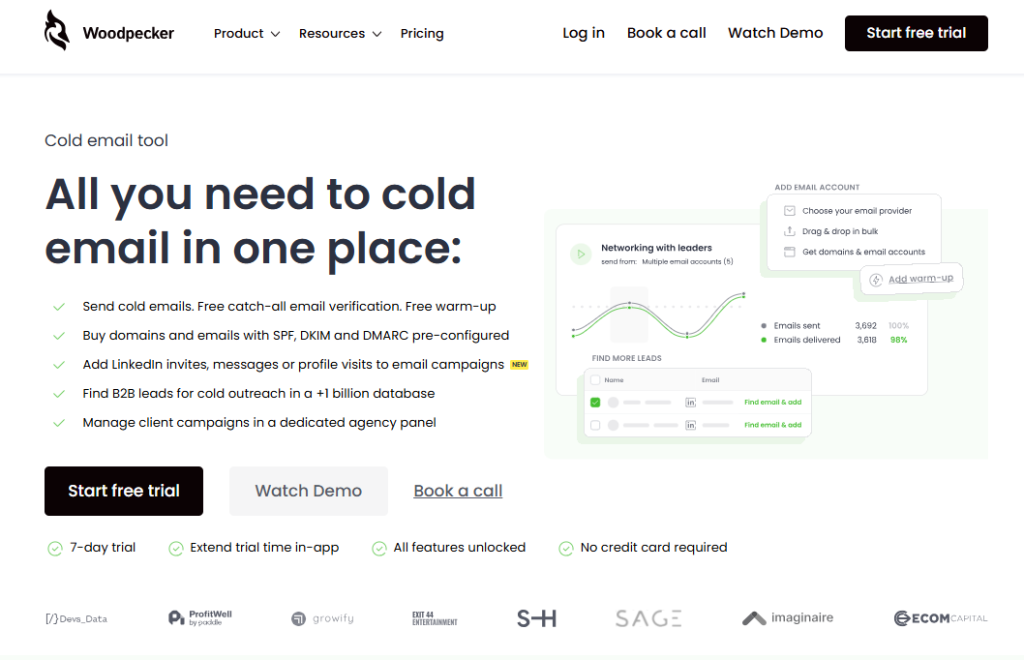
Outbound works when you combine strategy with the numbers. If your sales team focuses on personalization, follow-ups, and smaller lists, you’ll land far more qualified leads than by sending bulk cold emails.
Attract leads with inbound marketing and content
Inbound takes longer to build but pays dividends. The key is to create valuable content that attracts potential customers searching for solutions.
Smart inbound plays:
- Write proof-driven blogs like “How we cut CPCs by 37% for a fintech client” instead of generic how-tos.
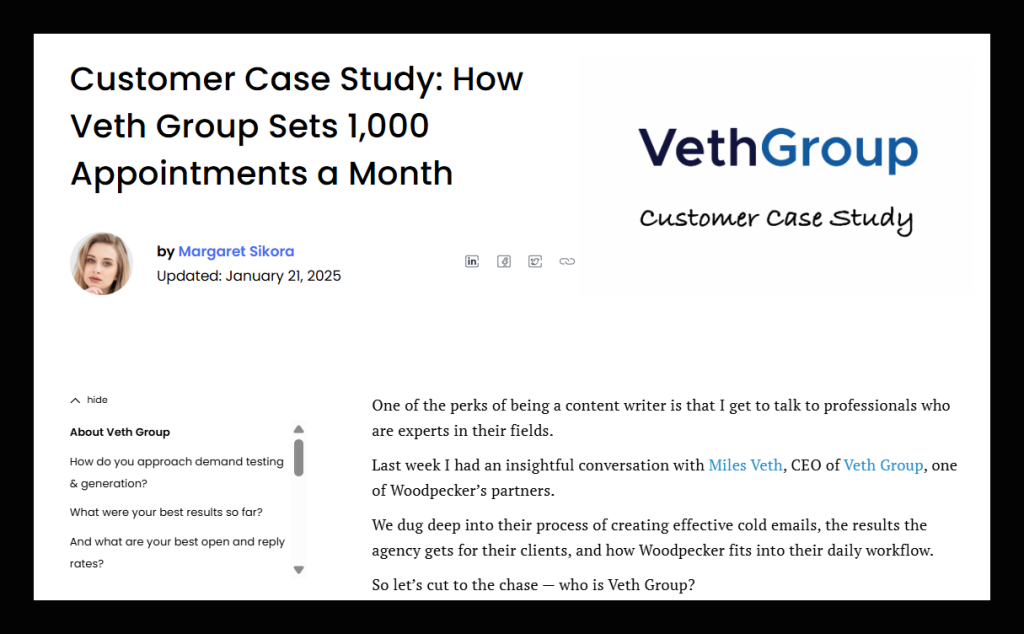
- Build calculators, checklists, or templates that double as lead magnets.
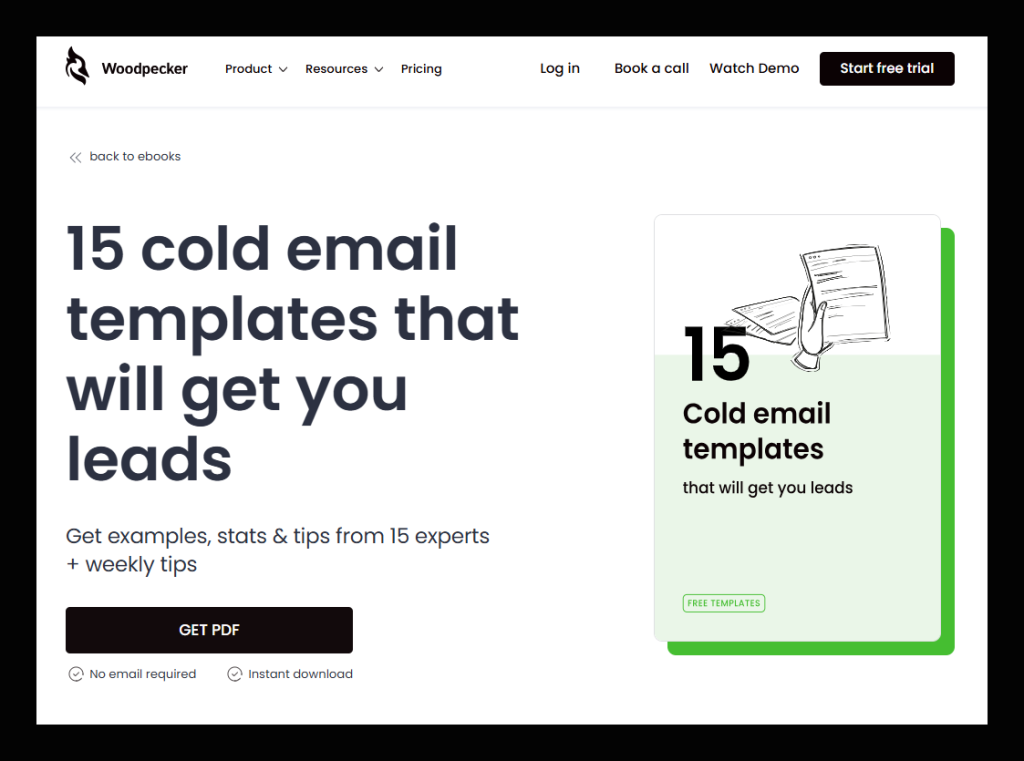
- Publish social media posts that show your agency’s thought process.
- Optimize for high intent keywords with tools like Google Search Console to bring in new leads.
This is how agencies create predictable inbound pipelines. Pair content marketing with email marketing to nurture leads until they’re ready for the sales team.
Agency referral engines
Inbound and outbound are powerful, but nothing beats a recommendation from someone your prospect already trusts. Referrals consistently bring in high quality leads because they arrive pre-qualified. A client or partner has already vouched for your work. The trick is to stop treating referrals as happy accidents and build them into your lead generation process.
Incentivize happy clients
A client who’s thrilled with your work is far more likely to mention you to a peer if there’s a clear nudge. That doesn’t always mean cash rewards. You can structure referral bonuses as discounts on next month’s retainer or a free add-on service. The point is to make referrals part of the conversation, not a hidden afterthought.
Here’s how we do it at Woodpecker:
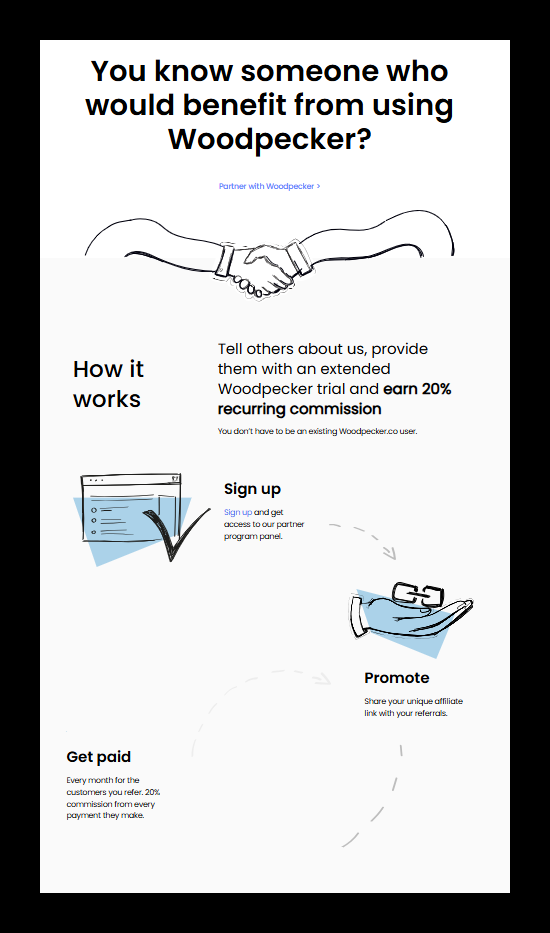
Partner with complementary agencies
No agency can be everything at once. A design studio that doesn’t do SEO, or a content shop that doesn’t run paid media, can be a great source of qualified leads for you. And you can send work back their way. These partnerships also protect you from losing leads outside your scope while still building trust with potential clients.
Turn referrals into a system
Referrals work best when they’re consistent. Try quarterly outreach to your client base with a simple ask: “Is there one other business in your network that could benefit from results like these?” Pair that with ongoing communication (case study updates, social media posts, or newsletters). This way, your agency stays top of mind. Over time, referrals shift from being random wins to a predictable source of more leads in your sales pipeline.
Social media marketing strategies to attract more leads
Social media platforms remain one of the strongest marketing channels for agencies. In 2025, 96% of small businesses and over 83% of agency marketers use social media as a primary marketing channel.
The challenge? Using them strategically.
- Use LinkedIn for B2B inbound marketing. Post valuable insights regularly, then send personalized messages to engage potential clients.
- Run targeted ads on Facebook or Instagram to capture contact details of potential customers.
- Share client wins, audits, and behind-the-scenes clips as social media posts to build authority.
- Combine organic + paid for maximum reach – organic for credibility, paid advertising for scale.
One mid-size agency in Berlin used this playbook on LinkedIn. They published weekly carousel posts breaking down client ad results, paired each with a short email marketing follow-up sequence, and ran small paid advertising boosts behind their best posts.
In three months, those posts generated 800 new followers, 120 demo requests, and 15 signed contracts.
The lesson? When combined with other marketing channels, social media becomes a consistent source of qualified leads.
With the right social media marketing strategies, you can keep a steady flow of more leads entering the sales funnel.
Content marketing as a lead generation engine
Content marketing is still one of the most powerful ways to generate leads if you publish with intent. In 2025, 74% of marketers say content marketing directly drives demand and leads, and it generates 3x more leads than outbound while costing 62% less per lead.
The key is focus:
- High intent keywords aligned with purchase-driven searches (“buy,” “best for,” “trial”) can reach 5%+ conversion rates, far higher than generic queries.
- Publishing long-form guides, niche playbooks, and consistent blog output (16+ per month) drives up to 4.5x more leads.
- Breaking down those assets into checklists, calculators, and PDFs creates ongoing lead magnets.
Content also nurtures. Many marketers structure content to move leads through the buyer’s journey, using:
- blogs and social posts for awareness,
- templates and webinars for consideration,
- and case studies or proposals at the decision stage.
When paired with email marketing sequences built around custom assets, businesses are seeing lead-to-close rates nearly double.
And don’t overlook search. AI Overviews and answer engines like Google’s AIO and Perplexity now shape discovery. Content that’s conversational, intent-driven, and backed by expertise earns higher clicks and stronger conversions from these channels.
In 2025/26, good content marketing is about publishing with precision: high intent keywords, assets for every funnel stage, and formats optimized for both human readers and AI search.
Lead generation services and tech stack
To build a repeatable lead generation process, agencies need the right tools:
- Outbound → Woodpecker (personalized outreach, follow-ups, deliverability tracking).
- Inbound → HubSpot, Capsule CRM, or other lead generation services for tracking and nurturing.
- Analytics → Dreamdata, Whatagraph to track key metrics and show ROI.
- Interactive lead magnets → Outgrow, involve.me for quizzes and calculators.
- Proposals → Qwilr, PandaDoc for branded docs that improve conversion rates.
This stack supports both inbound and outbound lead generation efforts, while keeping the sales process organized.
How to improve conversion rates across the sales funnel
Getting more leads doesn’t guarantee revenue. What matters is how well you move potential clients through the sales funnel and convert them into paying accounts.
Cold email stats prove this point. The average cold email response rate is just 1-5%, but with advanced personalization and consistent follow-ups, agencies can push that to 17-27%. That difference determines whether your sales pipeline is filled with high intent leads or stalls at the top of the funnel.
That’s why every lead generation strategy needs clear rules for:
- lead scoring to identify the most promising prospects,
- nurture campaigns (like email marketing or social media posts) to keep momentum,
- ongoing lead generation efforts that balance inbound and outbound.
By integrating personalization, targeting, and persistence into your sales process, you generate the kind of leads that actually convert.
Metrics and ROI tracking for lead generation efforts
Landing more leads is only half the battle. To know if your lead generation strategy is working, you need to track what happens after those leads enter your sales funnel.
That’s where metrics and ROI tracking come in.
Cost per opportunity
How much are you spending to book a qualified call or demo? This helps you compare the efficiency of different marketing channels. For example, paid advertising versus outbound lead generation.
Proposal win rate
Out of all proposals your sales team sends, how many actually close? A low win rate signals weak targeting or messaging, while a higher one shows that your lead quality is strong.
Average sales cycle
The number of days from first contact to signed deal. Long cycles can drain resources. Tracking this helps you refine your lead generation process and keep your sales pipeline moving.
Client lifetime value (LTV)
Revenue per client across the entire relationship. This metric ensures your sales team focuses on potential customers who bring long-term revenue growth, not just quick wins.
Sales velocity
How fast leads move through your funnel. Faster velocity means your sales process is aligned with your marketing team’s efforts, which creates consistent growth.
Tracking these metrics gives both your marketing team and sales team valuable insights on where to double down and where the process is leaking. It also makes it easier to show ROI to decision makers, which is critical for securing budgets and scaling lead generation services.
Common pitfalls in lead generation efforts
Even top agencies stumble. Watch out for:
- Relying only on inbound. SEO or social media platforms can shift overnight.
- Sending bulk cold emails without personalized messages (kills brand trust).
- Competing only on price instead of expertise.
- Generating too many unqualified new leads instead of high quality leads.
Avoiding these mistakes protects your reputation and guarantees sustainable growth.
Conclusion
The agencies that thrive in 2025 and 2026 will be those that treat lead generation strategy as a structured playbook.
That means combining inbound marketing with smart outbound lead generation, using tools like Woodpecker to reach the most promising prospects, and building trust with valuable content across social media platforms and other marketing channels.
Start simple: launch one outbound campaign, build one lead magnet, and align your sales team and marketing team on shared business goals. Measure results to refine the lead generation process, and repeat.
Agencies that focus on generating high quality leads and commit to consistent growth based on analytics will stand out from the crowd and build the kind of pipeline that fuels real revenue growth.

